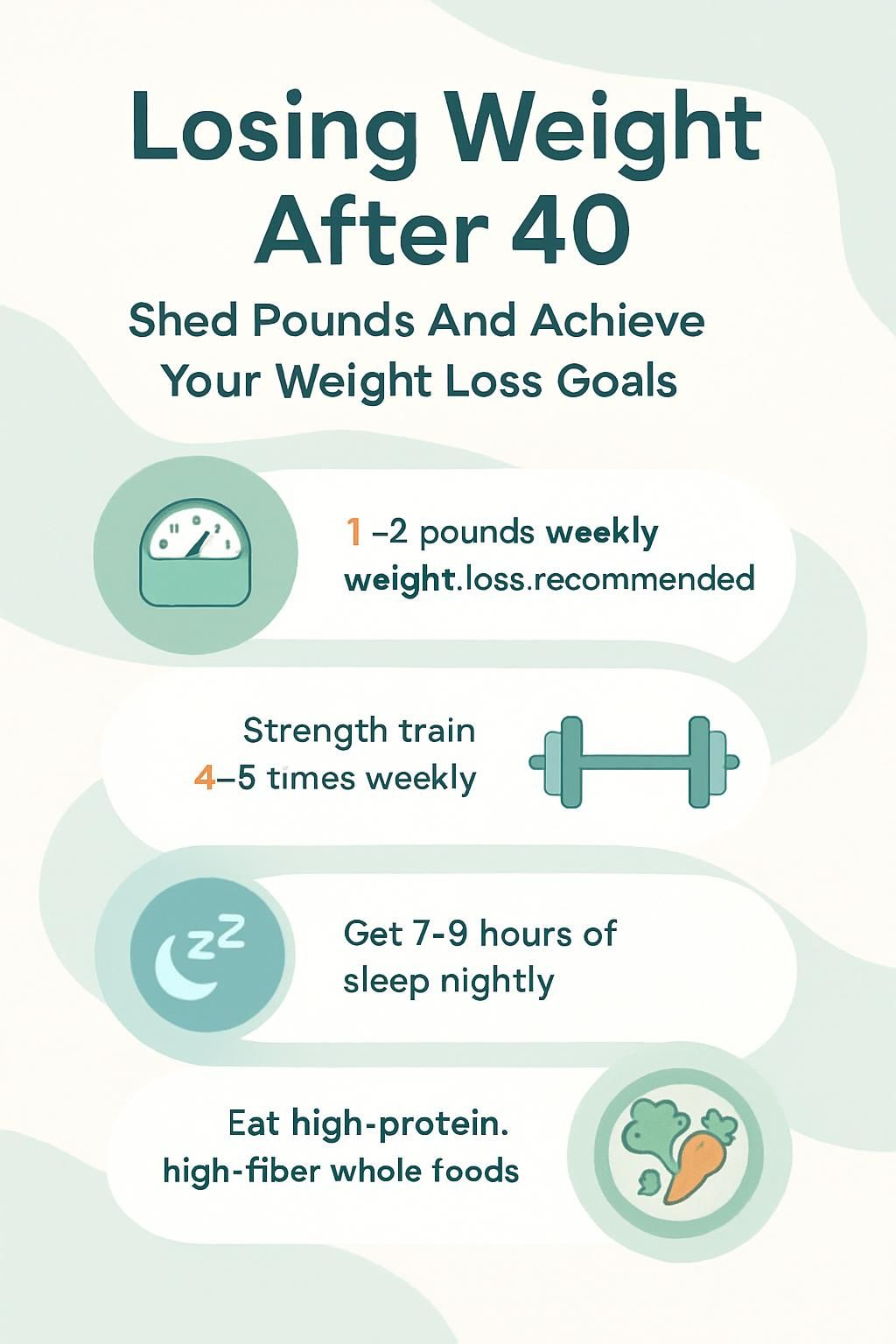Losing Weight After 40: Shed Pounds And Achieve Your Weight Loss Goals
Our Nutrition Assistant AI Suite will transform your body. You will lose fat, get toned, and build muscle. Gain confidence and optimal health.
Is it getting harder to lose weight after 40 even though your diet and exercise look the same? As we age, metabolism, the rate you burn calories, slows. Hormonal changes can also push more fat to your belly and hips.
This guide explains why weight loss can feel tougher in your forties and beyond. You will get simple, science-based steps that help you shed pounds and reach a healthy weight without extreme rules.
Key Takeaways
- After 40, slower metabolism and hormone shifts can lead to muscle loss and belly fat. A safe pace is 1 to 2 pounds per week, according to the CDC.
- Strength training four or five days per week plus at least 150 minutes of moderate cardio helps maintain muscle and burn more calories.
- Build meals around protein and fiber. Limit sugar, ultra-processed foods, large portions, and alcohol to control calories and hunger.
- Seven to nine hours of quality sleep supports appetite hormones. Stress tools like yoga or meditation can reduce cortisol-driven cravings.
- See a healthcare professional for sudden weight gain, fatigue, or stubborn symptoms. Ask about options such as thyroid testing or weight-loss medications if needed.

Common Reasons Why Losing Weight After 40 Is Difficult

Many adults notice new roadblocks after 40. Physical changes make it harder to keep weight off even if your routine does not change. Understanding why helps you pick the right fixes.
How does a slower metabolism affect weight loss after 40?
Metabolism slows with age, which means your body burns fewer calories at rest. Losing muscle is a key reason, since muscle burns more energy than fat. If you keep the same eating and activity level as in your thirties, weight often creeps up.
Lower estrogen and lower testosterone can add to belly fat and make fat loss slower. To lose weight and keep it off, you may need slightly fewer calories, more daily movement, or both. The Centers for Disease Control and Prevention suggests a steady pace of 1 to 2 pounds per week for long-term success.
One client told me, “After turning 40, I could not snack like before without gaining. Strength training helped me rebuild muscle and burn more calories each day.” That story is common, and it shows why muscle matters.
What hormonal changes impact weight management after 40?
During perimenopause and menopause, estrogen drops. This change can push more fat to the abdomen. Many women notice a thicker waist even if their habits are steady.
Testosterone declines in men and women over time. Less testosterone can mean less muscle and a slower calorie burn. Hunger and cravings may also shift during perimenopause.
If your weight, appetite, or energy changes fast, speak with a clinician. Ask about tests or treatment options, including hormone therapy when appropriate.
Why does muscle loss make losing weight harder after 40?
Sarcopenia, age-related muscle loss, speeds up after 40. Less muscle lowers your daily calorie burn. That means you need fewer calories to avoid weight gain, which can feel frustrating.
Lower muscle can also affect blood sugar control and raise the risk of insulin resistance. This pattern often shows up as more belly fat. Strength training with weights or bands two or three times per week helps. Many people do best with four or five sessions that use progressive overload, which means slowly adding weight, sets, or reps.
When I started lifting again in my mid-forties, my appetite felt steadier and my energy grew. That made healthy eating easier to maintain.
How does increased stress interfere with weight loss after 40?
Stress raises cortisol, a hormone that can increase appetite and belly fat. It also drives cravings for sugar and high-fat foods. Busy schedules make it easy to grab snacks and skip workouts.
Chronic stress can wreck sleep and reduce insulin sensitivity, which makes fat loss slower. During a hectic season at work, I craved junk food and slept poorly, and my progress stalled.
Stress turns on hunger cues that make it easy to reach for chips or sweets after a tough day.
Short walks, deep breathing, yoga, and brief meditation sessions help. These tools lower stress so you can make better choices and stick with habits.
What role does poor sleep play in weight gain after 40?
Sleeping less than seven hours can shift appetite hormones. Ghrelin, the hunger hormone, rises. Leptin, the fullness signal, falls. You feel hungrier, crave sugar, and often eat more at meals.
Poor sleep also makes your body less sensitive to insulin, which links to belly fat. Low energy the next day can push workouts aside. After I set a consistent bedtime and cut screen time, my hunger eased and my training improved.
Prioritize 7 to 9 hours of quality sleep. Good sleep makes healthy eating and daily movement far easier.
Strategies to Overcome Weight Loss Challenges
It is normal to face hurdles in your forties. With the right plan, you can lose weight after 40 and keep momentum.
How can I set realistic weight loss goals after 40?
Aim for 1 to 2 pounds per week. This pace protects muscle and helps hormone balance. Track more than the scale. Look at energy, sleep, fitness, and how your clothes fit.
Break big targets into small wins, like five-pound milestones. Progress can feel slower because metabolism changes with age. Focus on nourishment and consistency instead of harsh diets or marathon workouts.
What gradual lifestyle changes help with weight loss after 40?
Start with manageable steps. Pick activities you enjoy and build frequency over time. That is how habits stick.
- Move 150 to 300 minutes per week at a moderate pace. Brisk walking, dancing, or cycling all count.
- Strength train at least twice weekly to maintain skeletal muscle and support metabolism.
- Add mini-walks after meals and stand up more during the day.
- Plan meals that meet your protein needs and keep processed food lower.
- Cook extra protein for leftovers to save time and curb cravings.
- Use a food log or app to learn portion sizes and patterns.
As a parent in my forties, prepping fruits and vegetables on Sundays helped me skip random snacks. Small shifts build confidence and steady progress.
Nutrition Tips for Weight Loss After 40
Food choices can make weight loss smoother, especially as hormones and metabolism change. A few smart swaps add up fast.
Why should I prioritize whole foods for weight loss after 40?
Whole foods, like vegetables, fruit, lean protein, beans, and healthy fats, keep you full longer. Whole grains such as oats, brown rice, and whole-wheat bread add fiber and steady energy.
Since metabolism slows after 40, you need better fuel and fewer empty calories. Cooking at home helps you limit unhealthy oils and control portions. Planning ahead also makes it easier to hit your protein target, which protects muscle.
When I built meals around protein, whole grains, and produce, cravings dropped. Fiber supports gut health, which is tied to weight control and heart health.
How can increasing protein and fiber help me lose weight after 40?
Protein builds and protects muscle, which raises your daily calorie burn. Try grilled chicken, fish, eggs, lentils, tofu, or low-fat dairy at each meal. Preparing extra protein makes weekday meals quick.
Fiber from fruits, vegetables, beans, and whole grains slows digestion. You stay full longer, which helps you eat fewer calories. This combo also steadies appetite hormones, so it is easier to stop at satisfied.
Some postmenopausal women add soluble fiber supplements for extra support. Track intake with a simple journal or nutrition app if that helps you learn.
What are the effects of sugar and processed foods on weight after 40?
Sugary drinks, sweets, and ultra-processed snacks pack calories without nutrients. These options spike blood sugar and increase insulin, which over time can drive belly fat.
Swap refined choices for whole grains, legumes, and non-starchy vegetables. These foods steady blood sugar and support a healthier body shape.
How does limiting alcohol support weight loss after 40?
Alcohol adds calories quickly and lowers food restraint. More than one drink per day can slow progress, especially for women.
Cutting back improves appetite control and sleep quality. Better sleep can lower next-day cravings. Try keeping alcohol to less than one drink a day while you build consistent habits.
What are effective portion control methods for weight loss after 40?
Portion control reduces calories without relying on willpower alone. Simple tools make a big difference.
- Use smaller plates and bowls to make servings look larger.
- Measure calorie-dense foods like rice, nuts, and cheese with cups or a scale.
- Track meals with apps such as MyFitnessPal or Cronometer for a short season to learn amounts.
- Eat three satisfying meals to reduce random snacking and support gut health.
- Practice mindful eating, slow down, and stop at comfortable fullness.
Pre-measuring dinners helped me avoid seconds and led to steady losses. Research shows smaller portions can cut daily intake by hundreds of calories, which supports a safe weekly loss.
Effective Exercise Plans
Training should help you protect muscle and burn calories. A mix of strength work and cardio is best for weight management after 40.
Why is strength training important for weight loss after 40?
Strength training slows sarcopenia and keeps your metabolism humming. Plan four or five sessions per week if you can, and use progressive overload to keep improving.
More muscle helps you burn more calories at rest and improves blood sugar control. It can also reduce high cholesterol risk and support bone health. Simple moves like squats, rows, and kettlebell swings work well.
How do cardiovascular exercises aid weight loss after 40?
Cardio burns calories and supports fat loss. Aim for at least 150 minutes each week at a moderate pace. Good options include brisk walking, cycling, and swimming.
In midlife, hormone shifts can increase abdominal fat. Cardio helps reduce deep belly fat and supports healthy blood pressure. When I added daily biking, my waistline and energy improved.
What are the benefits of HIIT for weight loss after 40?
High-intensity interval training, or HIIT, uses short bursts of hard effort followed by rest. These sessions can burn more calories in less time. They also increase calorie use after your workout ends.
HIIT may improve insulin sensitivity, which helps with weight control. Many people see results with 20-minute sessions two or three times per week. Try sprints on a bike, fast walking up hills, or simple bodyweight intervals.
| Benefit | Evidence or Fact |
|---|---|
| Higher calorie burn | Burns more calories in less time |
| Boosts metabolic rate | Raises post-exercise calorie use |
| Fits busy schedules | Workouts can be 20 minutes |
| Improves insulin sensitivity | Supports metabolic health |
| Adds workout variety | Helps prevent plateaus |
How can I stay active throughout the day to lose weight after 40?
Daily movement supports your metabolism and reduces stress. Short activity breaks add up.
- Set a goal of 10,000 steps per day with a tracker or phone.
- Use a standing desk, and alternate sitting and standing each hour.
- Take a quick stretch break every 30 to 60 minutes.
- Pick fun activities like dancing, biking, or swimming several times a week.
- Walk while on calls, park farther away, or take the stairs.
- Cook more at home, and stay on your feet while prepping meals.
- Log daily movement to spot patterns and stay motivated.
These habits pair well with small lifestyle changes. Together, they help you keep weight off.
The Role of Sleep in Weight Loss
Sleep resets your brain and body. Good rest makes it easier to follow your plan and avoid cravings.
How much quality sleep do I need for weight loss after 40?
Aim for 7 to 9 hours each night. The CDC lists this range for healthy adults. Poor sleep disrupts appetite hormones and can lead to weight gain.
Consistent rest helps your tissues recover from workouts and keeps stress in check. After a rough week of short nights, I felt hungrier and skipped training. Improving sleep made healthy choices much easier.
What are simple ways to improve sleep hygiene for weight loss?
Better sleep habits can reduce cravings and support steady weight loss.
- Keep a consistent sleep and wake time, even on weekends.
- Limit screens before bed because bright light can delay sleep.
- Keep your bedroom dark and cool, about 60 to 67°F.
- Avoid caffeine in the afternoon and evening.
- Skip heavy meals late at night to protect digestion and sleep.
- Use calming routines like reading, meditation, or gentle stretches.
- Drink water through the day, then taper one hour before bed.
For me, setting a bedtime and turning off my phone an hour early made a clear difference in sleep and hunger control.
Stress Management for Weight Loss
Stress can nudge you to eat more and move less. A simple toolkit helps you keep balance.
How can mindfulness and meditation reduce stress-related weight gain?
Mindfulness and meditation can lower cortisol, which is tied to belly fat. These practices reduce emotional eating and improve food choices during tense moments.
They also support sleep, which helps with appetite control. A few minutes a day is enough to start building the habit.
What yoga or deep breathing exercises help manage stress and weight?
Yoga and breathing work reduce tension and improve focus. They can also support muscle tone and joint mobility.
- Try Hatha yoga for gentle stretching and relaxation.
- Use Vinyasa yoga to pair movement with breath and raise your heart rate.
- Practice diaphragmatic breathing to calm your nervous system.
- Do five minutes of mindful breathing daily to steady hormones.
- Join a group class for extra support and accountability.
- Use restorative poses like Child’s Pose or Legs-Up-the-Wall before bed.
- Combine light morning yoga and breathing to start with clarity.
These methods support lower stress, better movement, and steadier habits after 40.
How can I avoid emotional eating caused by stress?
Plan ahead for stressful times. Keep easy, healthy options ready. Pause and assess your hunger level before you eat.
Move your body to lower stress, even if it is a quick walk. Call a friend or write down what you feel. Many people see fewer emotional eating episodes when they use these steps often.
Hormonal Balance and Weight Management
Hormone shifts change appetite, mood, and where your body stores fat. Knowing this helps you adjust your plan with less frustration.
How do menopause and testosterone decline affect weight after 40?
During perimenopause and menopause, estrogen drops and belly fat often rises. Many women gain a few pounds even without changing habits.
Testosterone also declines with age in both sexes. Lower levels can lead to muscle loss and slower metabolism. I needed more protein and regular strength training once these changes started. Old routines were no longer enough.
When should I consult a healthcare professional about hormone health?
Seek medical advice for unexplained weight gain, fatigue, or persistent belly fat. Ask about thyroid checks if you have cold intolerance, low energy, or hair loss. These can be signs of hypothyroidism.
Discuss hormone therapy for menopause when appropriate. Ask your clinician whether weight-loss medicines such as semaglutide, tirzepatide, metformin, or topiramate fit your health profile. This article is for education only and does not replace medical care.
Additional Tips to Support Weight Loss After 40
Small daily actions support your plan and keep motivation steady. Choose the ideas that fit your life best.
Why is staying hydrated important for weight loss after 40?
Water helps control appetite and supports metabolism. Drinking a glass before meals may reduce calories eaten.
Start the day with water, with a squeeze of lemon if you like the taste. Keeping a bottle at your desk helped me avoid mindless snacking. Even mild dehydration can lower energy and make workouts feel harder. Set phone reminders if needed.
How should I monitor my progress effectively after 40?
Track body composition, not just scale weight. Use a tape measure or a smart scale to watch trends. DEXA scans are the most accurate, but home tools work for day-to-day tracking.
Look for signs like better-fitting clothes, more energy, and strength gains. Because weight can fluctuate, judge progress over weeks, not days. Keep a simple log of your key numbers and how you feel.
What is the connection between gut health and weight loss after 40?
Fiber-rich foods support helpful gut bacteria. A healthy gut can improve digestion, hunger control, and weight management.
Many people do better with three solid meals and limited snacking to give the gut time to rest. Cooking at home lets you add probiotic foods and soluble fiber that support a steady metabolism.
Why should I avoid fad diets when losing weight after 40?
Fad diets often cut calories too hard or remove whole food groups. These plans can cause muscle loss, a slower metabolism, and rebound weight gain.
After 40, your body benefits from steady nutrition. Choose balanced meals, patient progress, and self-care. These steps are easier to keep for life.
Seeking Professional Help
Expert support can save time and reduce guesswork. Guidance is useful if your progress has stalled or health issues show up.
How can a registered dietitian support my weight loss after 40?
A registered dietitian reviews your medical history and daily routine, then builds a plan that fits your needs. Mine helped me dial in portions after my doctor noted insulin resistance at 45.
Dietitians tailor protein and fiber goals, help with food allergies, and advise on supplements like vitamin D or omega 3s if needed. Regular check-ins keep you accountable and can improve long-term results.
When should I consult a personal trainer for exercise plans?
If you are new to exercise or returning after a break, a trainer can create a safe plan. Proper form and steady progress help prevent injury and build confidence.
Goals vary from fat loss to muscle gain to better mobility. A trainer can adjust your plan to match your body and schedule. This guidance turns strength training into your most reliable ally after 40.
What medical conditions could affect weight loss after 40?
Hypothyroidism can slow metabolism and raise fatigue. Insulin resistance is common with age and links to stubborn belly fat and a higher risk of type 2 diabetes.
Hormone shifts, certain medicines, and joint pain can also play a role. Ask your clinician to screen for issues before changing your plan. Treating root causes makes weight loss safer and more effective.
Maintaining Long-Term Weight Loss Success
Lasting weight loss depends on habits, not perfection. Build routines that fit your life and adjust as needed.
How can I stay consistent and make weight loss sustainable after 40?
Turn small actions into daily habits. Walk after dinner, prep simple meals, and strength train on set days. Repeating the same behavior in the same context helps it stick.
Plan a weekly free meal to reduce feelings of restriction. Some people like macro tracking, but skip it if logging triggers stress. The goal is steady progress, not rigid rules.
What role does a supportive environment play in maintaining weight loss?
Social support keeps you on track. Group classes, walking partners, or a coach increase consistency and results.
Plan meals with family, share wins, and talk through setbacks. In my home, grocery shopping with my partner made healthy eating easier for both of us.
Why is celebrating small wins important for long-term success?
Small wins build momentum. A looser waistband, extra reps, or better sleep are all signs your plan works.
Track non-scale victories and keep moving forward. “Correct and continue. Let it go and move on” is a helpful reminder after hard days.
Conclusion
Reaching your weight loss goals after 40 is possible. Focus on strength training, daily movement, and balanced meals built around protein and fiber. Manage stress, protect sleep, and keep alcohol modest.
Set realistic goals, track trends, and adjust as your body changes. Ask professionals for help when needed, especially for hormone or medical concerns. With steady steps, you can lose weight after 40 and maintain weight loss for the long term.
FAQs
1. Why is losing weight after 40 more difficult than before?
Metabolism slows as people age, leading to fewer calories burned at rest. Hormonal changes, such as lower estrogen or testosterone, can also increase fat storage and reduce muscle mass. Research from the National Institutes of Health shows that adults over 40 may lose muscle more quickly, which further slows metabolism.
2. What are effective strategies for weight loss after age 40?
Focus on a balanced diet with lean proteins, whole grains, fruits, and vegetables. Strength training helps preserve muscle and boost metabolism. Regular aerobic activity supports heart health and calorie burn. A study in the Journal of Nutrition found that combining resistance exercise with higher protein intake led to greater fat loss in adults over 40.
3. How does sleep affect weight loss for people over 40?
Poor sleep disrupts hormones that control hunger and fullness, making it harder to manage weight. The Sleep Foundation reports that adults who get less than seven hours per night are more likely to gain weight than those who sleep longer.
4. Can personal experience help motivate weight loss after 40?
Personal stories often inspire others to start or continue their own journey. For example, one reader shared how tracking meals and joining a walking group helped her lose 20 pounds after turning 45. Support from friends or family can make healthy habits easier to maintain.
Summary: Weight loss after 40 requires attention to diet, exercise, sleep, and support systems. Scientific studies confirm these strategies help overcome age-related challenges to achieve lasting results.







